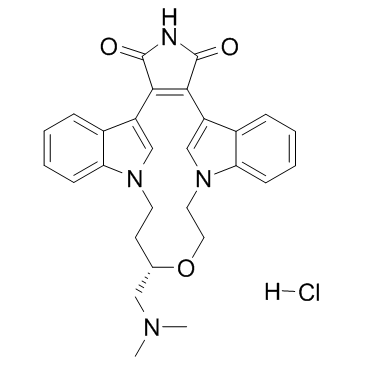
Ruboxistaurin hydrochloride
CAS No. 169939-93-9
Ruboxistaurin hydrochloride( LY333531 hydrochloride | LY-333531 hydrochloride )
Catalog No. M12593 CAS No. 169939-93-9
A potent, selective, ATP-competitive, orally available PKC beta (PKCβ) inhibitor with IC50 of 4.7 and 5.9 nM for PKCβ I and PKCβ II, respectively.
Purity : >98% (HPLC)
 COA
COA
 Datasheet
Datasheet
 HNMR
HNMR
 HPLC
HPLC
 MSDS
MSDS
 Handing Instructions
Handing Instructions
| Size | Price / USD | Stock | Quantity |
| 5MG | 143 | In Stock |


|
| 10MG | 243 | In Stock |


|
| 25MG | 486 | In Stock |


|
| 50MG | 701 | In Stock |


|
| 100MG | 981 | In Stock |


|
| 500MG | 1962 | In Stock |


|
| 1G | Get Quote | In Stock |


|
Biological Information
-
Product NameRuboxistaurin hydrochloride
-
NoteResearch use only, not for human use.
-
Brief DescriptionA potent, selective, ATP-competitive, orally available PKC beta (PKCβ) inhibitor with IC50 of 4.7 and 5.9 nM for PKCβ I and PKCβ II, respectively.
-
DescriptionA potent, selective, ATP-competitive, orally available PKC beta (PKCβ) inhibitor with IC50 of 4.7 and 5.9 nM for PKCβ I and PKCβ II, respectively; displays >60-fold selectivity over PKCα, and other ATP dependent kinases (PKA, Calcium calmodulin, Caesin kinase and Src); ameliorates the glomerular filtration rate, albumin excretion rate, and retinal circulation in diabetic rats.Heart Failure Phase 2 Discontinued.
-
In VitroRuboxistaurin hydrochloride is a selective and ATP-competitive PKCβ inhibitor, with IC50s of 4.7 and 5.9 nM for PKCβI and PKCβII, shows less potent inhibition on PKCη (IC50, 52 nM), PKCα (IC50, 360 nM), PKCγ (IC50, 300 nM), PKCδ (IC50, 250 nM), and has no effect on PKCζ (IC50, >100 μM). Ruboxistaurin (10 and 400 nM) dramatically inhibits glucose-induced monocyte adherence to levels that are not different from baseline adherence of monocytes to endothelial cells under NG conditions. Ruboxistaurin (10 and 400 nM) dose not alter the endothelial expression of adhesion molecules or modify endothelial cell growth. Ruboxistaurin (LY333531; 10 nM) reduces high-glucose (HG)-induced human renal glomerular endothelial cells (HRGECs) viability, and inhibits the increases in swiprosin-1 in HRGECs incubated with HG.
-
In VivoRuboxistaurin (1 mg/kg; 8 weeks) markedly reduces GEC apoptosis as well as swiprosin-1 upregulation, and ameliorates renal glomerular injury in the diabetic mice. Ruboxistaurin also potently attenuates the expression of PARP, cleaved-caspase9, cleaved-caspase3, and the Bax/Bcl-2 ratio, in diabetic mice. Ruboxistaurin (0.1, 1.0, or 10.0 mg/kg; p.o.) dramatically reduces the number of leukocytes trapped in the retinal microcirculation of diabetic rats.
-
SynonymsLY333531 hydrochloride | LY-333531 hydrochloride
-
PathwayAngiogenesis
-
TargetPKC
-
RecptorPKCβ1|PKCβ2|PKCγ|PKCδ|PKCη
-
Research AreaMetabolic Disease
-
Indication——
Chemical Information
-
CAS Number169939-93-9
-
Formula Weight505.0079
-
Molecular FormulaC28H29ClN4O3
-
Purity>98% (HPLC)
-
SolubilityDMSO: 6.8 mg/mL (Need ultrasonic and warming)
-
SMILESCN(C)CC1CCN2C=C(C3=CC=CC=C32)C4=C(C5=CN(CCO1)C6=CC=CC=C65)C(=O)NC4=O.Cl
-
Chemical Name9H,18H-5,21:12,17-Dimethenodibenzo[e,k]pyrrolo[3,4-h][1,4,13]oxadiazacyclohexadecine-18,20(19H)-dione, 9-[(dimethylamino)methyl]-6,7,10,11-tetrahydro-, monohydrochloride, (9S)- (9CI)
Shipping & Storage Information
-
Storage(-20℃)
-
ShippingWith Ice Pack
-
Stability≥ 2 years
Reference



-
TV 3279
TV 3279 is a novel ChE-MAI inhibitor , and the neuroprotective properties depend on their ability to induce the anti-apoptotic proteins PKC, Bcl-2, Bcl-x, and SOD, and to block the nuclear translocation of the pro-apoptotic enzyme glyceraldehyde phosphate dehydrogenase in PC-12 and neuroblastoma cells.
-
PKCiota-IN-2
PKCiota-IN-2 (PKCiota-IN-49) is a selective and potent PKCiota (PKC-ι) inhibitor with an IC50 of 2.8 nM. PKCiota-IN-2 also inhibits PKC-α and PKC-ε with IC50s of 71 nM and 350 nM, respectively
-
Palmitoylcarnitine c...
Palmitoylcarnitine chloride (Palmitoyl DL-carnitine chloride) is a mitochondrial fatty acid oxidation intermediate that mediates intralipid cardioprotection.



 Cart
Cart
 sales@molnova.com
sales@molnova.com


